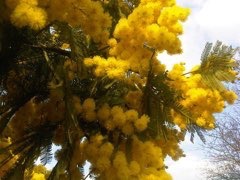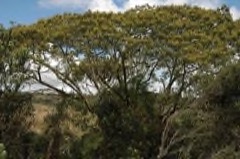 |
|
Emoke Dénes wikimedia.org |
 |
| Valerio Pillar wikimedia.org |
Translate this page:
Summary
Mimosa scabrella is a fast-growing tree reaching a height of up to 15 m and a trunk diameter of about 10 - 50 cm. It is a cross pollinating species and capable of fixing atmospheric nitrogen. It is used as a shade tree in coffee plantations and as green manure. The leaves are bipinnate and yellow green, forming a large, open, and rounded canopy. The white to yellow flowers are formed into clusters at the leaf bases. The seeds are small and brown. M. scabrella has many uses in paper production and honey production. Its wood is moderately heavy and hard, but of low durability. It is used mainly for veneers and boxes.
Physical Characteristics

 Mimosa scabrella is a deciduous Tree growing to 10 m (32ft) by 12 m (39ft) at a fast rate.
Mimosa scabrella is a deciduous Tree growing to 10 m (32ft) by 12 m (39ft) at a fast rate.
See above for USDA hardiness. It is hardy to UK zone 10. The flowers are pollinated by Bees.
It can fix Nitrogen.
Suitable for: light (sandy), medium (loamy) and heavy (clay) soils, prefers well-drained soil and can grow in nutritionally poor soil. Suitable pH: mildly acid and neutral soils and can grow in very acid soils.
It cannot grow in the shade. It prefers moist or wet soil. The plant is not wind tolerant.
UK Hardiness Map
US Hardiness Map
Synonyms
Mimosa bracaatinga Hoehne
Plant Habitats
Edible Uses
References More on Edible Uses
Medicinal Uses
Plants For A Future can not take any responsibility for any adverse effects from the use of plants. Always seek advice from a professional before using a plant medicinally.
None known
References More on Medicinal Uses
The Bookshop: Edible Plant Books
Our Latest books on Perennial Plants For Food Forests and Permaculture Gardens in paperback or digital formats.

Edible Tropical Plants
Food Forest Plants for Hotter Conditions: 250+ Plants For Tropical Food Forests & Permaculture Gardens.
More

Edible Temperate Plants
Plants for Your Food Forest: 500 Plants for Temperate Food Forests & Permaculture Gardens.
More

More Books
PFAF have eight books available in paperback and digital formats. Browse the shop for more information.
Shop Now
Other Uses
Containers Fencing Fuel Pioneer Soil conditioner Wood
Agroforestry Uses: A natural pioneer species within its native range, it is fast-growing and also fixes atmospheric nitrogen. It can be used as part of a mixed planting in native reforestation projects[419 ]. The tree is used to provide shade in highland coffee plantations in Cameroon and Central America[303 ]. The tree sheds large quantities of nitrogen-rich leaves that decompose rapidly and form rich humus, whilst its attractive flowers make it a pleasant live fence[303 ]. Other Uses The heartwood is tinted a greyish-rose colour; the sapwood is pinkish. The texture is medium; the grain straight. The wood is hard, moderately heavy, of low durability under adverse circumstances, with a moderately rough surface without lustre. Hard to cut, the wood is used in house construction, indoor finishing, and mainly for veneers and boxes[419 ]. The wood makes a high-quality fuel, although charcoal made from it produces a large amount of ash[303 , 419 ].
Special Uses
Food Forest Nitrogen Fixer
References More on Other Uses
Cultivation details
Native to the cool, subtropical plains of southeastern Brazil, the plant it is very robust and can grow in both warmer and drier areas. It is not recommended, however, for areas with mean annual temperatures higher than 23°c. It is found in areas where the mean annual rainfall ranges from 600 - 3,500mm and is spread through the year, though it is also able to tolerate dry periods of up to 4 months[303 ]. Requires a sunny position[419 ]. Succeeds in most soils and conditions[419 ]. Prefers a freely-draining soil, being intolerant of waterlogged, compacted or severely degraded soils[303 ]. Tolerant of strongly acid soils with a pH as low as 4.8, and also those soils with high aluminium content[303 ]. Grows best in a position sheltered from strong winds[303 ]. A fast-growing species, easily reaching a height of 3.5 metres within 2 years from seed[419 ].Fourteen month old trees up to 5 metres tall have been recorded; in 2 years they have reached 8 - 9 metres; and some 3 year old specimens have reached 15 metres[303 ]. Plantations have been harvested on rotations as short as 3 years, though fuelwood plantations in Brazil are more commonly planted at spacings of 2 x 2 or 3 x 3 m and harvested on 3 - 7 year rotations[303 ]. This species does not coppice well, though it can be pollarded or pruned effectively[303 ]. This species has a symbiotic relationship with certain soil bacteria; these bacteria form nodules on the roots and fix atmospheric nitrogen. Some of this nitrogen is utilized by the growing plant but some can also be used by other plants growing nearby[755 ].
References Carbon Farming Information and Carbon Sequestration Information
Temperature Converter
Type a value in the Celsius field to convert the value to Fahrenheit:
Fahrenheit:
The PFAF Bookshop
Plants For A Future have a number of books available in paperback and digital form. Book titles include Edible Plants, Edible Perennials, Edible Trees,Edible Shrubs, Woodland Gardening, and Temperate Food Forest Plants. Our new book is Food Forest Plants For Hotter Conditions (Tropical and Sub-Tropical).
Shop Now
Plant Propagation
Seed - it has a hard seedcoat and, unless sown as soon as it is ripe and still moist, may benefit from scarification before sowing to speed up germination. This can usually be done by pouring a small amount of nearly boiling water on the seeds (being careful not to cook them!) and then soaking them for 12 - 24 hours in warm water. By this time they should have imbibed moisture and swollen - if they have not, then carefully make a nick in the seedcoat (being careful not to damage the embryo) and soak for a further 12 hours before sowing. Sow the seed in a partially shaded position in individual containers or in a nursery seedbed. A high germination rate can be expected, with the seed sprouting within 20 - 30 days[419 ]. When the nursery bed sown seedlings are 4 - 5cm tall, pot them up into individual containers. Seedlings grow very quickly and should be ready to plant out 3 - 4 months later[419 ].
Other Names
If available other names are mentioned here
abaracaatinga - Portuguese, bracaatinga - Portuguese, bracatinga - Portuguese.
Native Range
SOUTHERN AMERICA: Brazil (Paraná, Rio de Janeiro (west), Rio Grande do Sul (northeast), Santa Catarina, São Paulo (east))
Weed Potential
Right plant wrong place. We are currently updating this section.
Please note that a plant may be invasive in one area but may not in your area so it's worth checking.
Conservation Status
IUCN Red List of Threatened Plants Status : This taxon has not yet been assessed

Growth: S = slow M = medium F = fast. Soil: L = light (sandy) M = medium H = heavy (clay). pH: A = acid N = neutral B = basic (alkaline). Shade: F = full shade S = semi-shade N = no shade. Moisture: D = dry M = Moist We = wet Wa = water.
Now available:
Food Forest Plants for Mediterranean Conditions
350+ Perennial Plants For Mediterranean and Drier Food Forests and Permaculture Gardens.
[Paperback and eBook]
This is the third in Plants For A Future's series of plant guides for food forests tailored to
specific climate zones. Following volumes on temperate and tropical ecosystems, this book focuses
on species suited to Mediterranean conditions—regions with hot, dry summers and cool, wet winters,
often facing the added challenge of climate change.
Read More
Expert comment
Author
Benth.
Botanical References
Links / References
For a list of references used on this page please go here
A special thanks to Ken Fern for some of the information used on this page.
Readers comment
| Add a comment |
|
If you have important information about this plant that may help other users please add a comment or link below. Only comments or links that are felt to be directly relevant to a plant will be included. If you think a comment/link or information contained on this page is inaccurate or misleading we would welcome your feedback at [email protected]. If you have questions about a plant please use the Forum on this website as we do not have the resources to answer questions ourselves.
* Please note: the comments by website users are not necessarily those held by PFAF and may give misleading or inaccurate information.
To leave a comment please Register or login here All comments need to be approved so will not appear immediately.
|
Subject : Mimosa scabrella
|
|
|
|